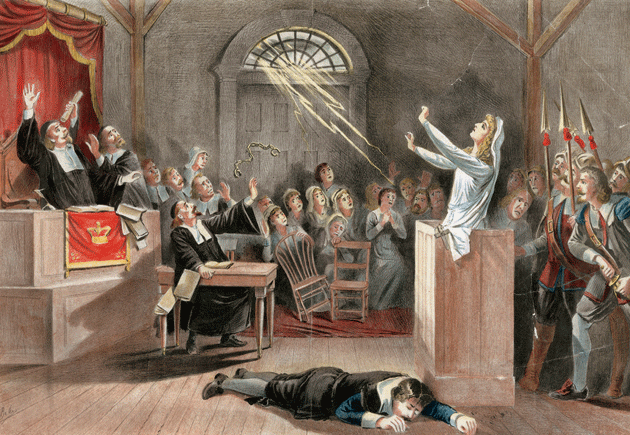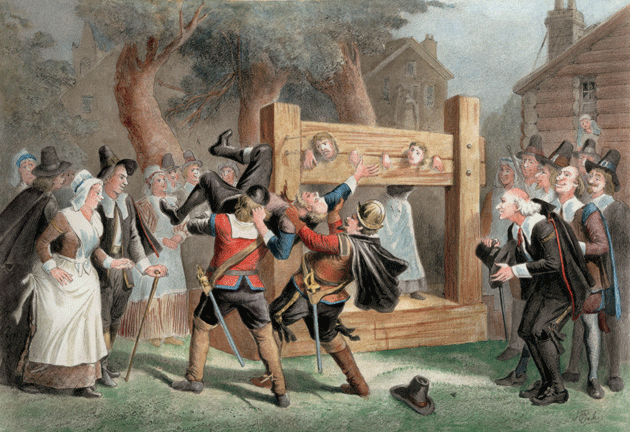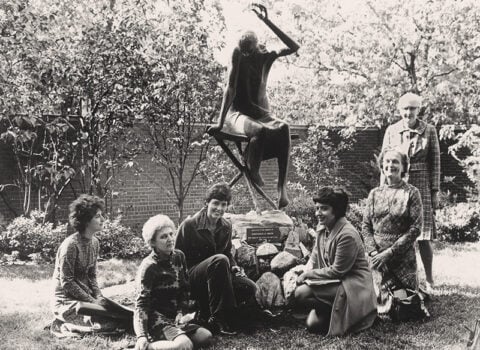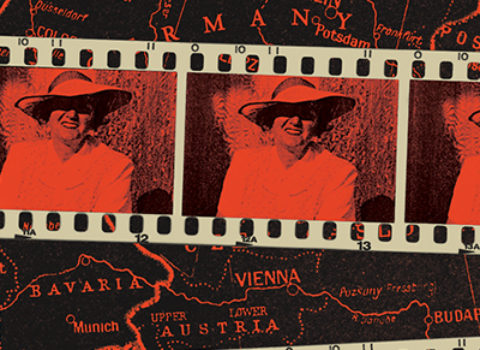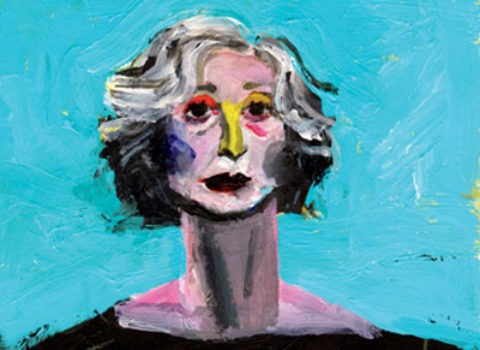Discussed in this essay:
The Witches: Salem, 1692, by Stacy Schiff. Little, Brown. 512 pages. $32.
We Believe the Children: A Moral Panic in the 1980s, by Richard Beck. PublicAffairs. 352 pages. $26.99.
One night in May 1692, Ann Foster and Martha Carrier hopped on a pole in Andover, Massachusetts, and flew twelve miles to a meadow in Salem Village. They picnicked on the grass and drank from a nearby brook before attending a meeting of about two dozen witches — a small fraction of the total number in New England at the time. The details of the meeting are unknown, but its purpose is not: the witches vowed to destroy Salem Village and set up “the devil’s kingdom” there. At her trial, Carrier denied everything; she was hanged for witchcraft in August. Foster confessed and survived in the Salem jail until December: under the strange rules that governed the village at the time, those who confessed to witchcraft were not put to death. After she died in prison — technically of natural causes, which were no doubt hastened by the jail’s freezing, vermin-infested conditions — her son had to pay the bill for her upkeep, including the chains that shackled her, before he was allowed to bury her body.
In The Witches, her new book examining the Salem witchcraft trials, Stacy Schiff calls the events that took place in the Massachusetts Bay Colony in 1692 — during which some two hundred people were accused of witchcraft, more than a hundred were imprisoned, and nineteen were executed — a “national nightmare” that “crackles, flickers, and jolts its way through American history and literature.” Like a dream, its images linger in the mind, half remembered and half imagined, equal parts tragedy and shame. The tragedy is obvious; the shame, more hidden. A sign of it, perhaps, is that, despite the Puritans’ typical fanaticism for record-keeping, the historical record of the events is incomplete. Cotton Mather, a Puritan minister and Salem’s most comprehensive and renowned chronicler — he published twenty-two books between 1689 and 1691 alone — wrote his diary for 1692 in retrospect. The letters and diaries of Mather’s contemporaries, many of whom were meticulous chroniclers themselves, mysteriously elide the crucial months of the trials. As Schiff points out, the voices of the women at the heart of the drama — both the accusers and the accused — are the most difficult to make out, passed down to us by notetakers who were “far from thorough, seldom impartial, and not always transcribing in the room in which they heard [the] statements.” It is no wonder that Salem remains one of the darkest, strangest, and least understood episodes in American history.
Most writers would consider such gaps in the record a drawback. Schiff seems to regard them as a personal challenge. In her previous biographies, she drew complex, nuanced portraits of figures about whom little was known or whose histories had been overtaken by myth: Antoine de Saint-Exupéry, who died mysteriously not long after completing his uncanny fable The Little Prince, one of the best-loved children’s books of the twentieth century; Véra Nabokov, who projected the image of a demure wife but wielded spectacular behind-the-scenes power; and, most recently, Cleopatra, whose character Schiff reconstructed from a bare-bones historical record. Now she brings her gifts to the confusions of Salem, piecing together a dramatic narrative from disparate and often tersely unrevealing sources, including diaries, memoirs, and court reports. She never lacks for an apt detail, drawing on academic studies that focus on everything from the region’s sexual mores to the way sounds echoed in the atmosphere.
Yet for all Schiff’s historical acumen and storytelling flair, the mystery at the heart of her book remains unsolved — as perhaps it must. Explanations for the madness, at least hypothetical ones, can be marshaled from many perspectives. The colonists were under extreme physical and psychic pressure. The adolescent girls who provoked the crisis were suffering from a classic case of Freudian hysteria. It’s not impossible, though Schiff doesn’t entertain the theory, that a fungus containing hallucinogenic chemicals may have infected the rye crop that year, causing many of the symptoms the girls experienced. But persuasive as some of these theories may be, none addresses the real question of Salem: not just why it happened but why it continues to happen. That fatal repetition, and not the horrifying events that unfolded over a few months at the tail of the seventeenth century, is the true national nightmare, the American curse for which no counter-hex has yet been discovered.
The trouble in Salem began in January 1692, in the depths of an uncommonly brutal winter, when nine-year-old Betty Parris and eleven-year-old Abigail Williams, the daughter and niece of Samuel Parris, the village’s minister, began to complain of bites and pinches from “invisible agents.” The girls suffered from fits; they babbled deliriously and barked like dogs. Their condition was horrendously disruptive: even if Parris had been able to ignore their cries long enough to prepare his thrice-weekly sermons, he could hardly avoid the curious visitors who overran the household at all hours. At a time when children as young as five were relied on for heavy chores, such as spinning flax or sewing, the loss of the girls’ labor was a hardship for Parris, who had to manage his ministry and tend to a farm at the same time. (In a sign of just how strenuous life in the new colonies could be, the first person in New England who confessed to entering into a diabolical pact, a servant in Connecticut, had asked the devil for help with her chores.) The girls’ afflictions quickly spread to their friends and neighbors: in the courtroom, they acted, Schiff writes, as a “demented acrobatics troupe,” screaming and convulsing throughout the trials.
One day when Parris and his wife were out of town, a neighbor took it upon herself to discover the cause of Abigail and Betty’s bewitchment. Following a familiar superstition, she directed John Indian, one of the family’s servants, to prepare a “witch cake” from the girls’ urine and to feed it to the family dog to reveal the source of the enchantment. The cake worked: the girls named several local women as their tormentors. The first was Sarah Good, a sporadically homeless beggar. Schiff describes her as “something of a local menace” who “would seem to have wandered into the village directly from the Brothers Grimm, were it not for the fact that they had not been born yet.” Good’s father committed suicide when she was eighteen, her first husband died and left her all his debts, and a series of lawsuits impoverished her; she had recently visited the parsonage to beg. Those who gave her charity tended to regret it: a local couple who took her in threw her out after six months because she was “so maliciously bent,” threatening them and insulting their children. Questioned by John Hathorne, a justice of the peace who took charge of the interrogations, Good refused to explain her odd behavior. Her own husband eventually testified against her for acting malevolently toward him, calling her “an enemy to all good.”
Pressed to name an accomplice, Good suggested Sarah Osborne, who had also been identified by the girls. This was only logical: since Good knew that she was herself no witch, Osborne must have been the culprit. But Osborne had been ill and bedridden for several years and could hardly have conveyed an impression of menace. (She died in jail soon after her arrest.) The only other possibility was Tituba, a slave in Parris’s household, who had also been named. (John Indian, the baker of the witch cake, was her husband.) She played the part of witch well, inventing stories with all the gusto of a “satanic Scheherazade,” as Schiff puts it. Tituba said that a tall, white-haired man in a dark serge coat had appeared in the parsonage one day and threatened to kill her if she did not hurt the girls. With him was a yellow bird, which he offered her. Good and Osborne, she said, had also given her orders.
Soon other “witches” would be named by these girls and their peers: Martha Corey, who had given birth to a biracial son before her first marriage, was imprisoned along with her husband; then Rebecca Nurse, a devout great-grandmother who had raised eight of her own children, as well as an orphan. “Hard of hearing, and full of grief,” as she pathetically told her interrogator, Nurse had trouble making out some of the questions put to her. These women were only the beginning. The list of those accused in Salem was not restricted by gender, social standing, or even species: it included more than forty men and nearly 150 women, from pillars of society to impoverished wretches, as well as two dogs.
According to the definition proposed by the English clergyman Joseph Glanvill, whose Saducismus Triumphatus (1681) was a cornerstone text in the history of witchcraft and well known to late-seventeenth-century New Englanders, a witch was “one who can do or seems to do strange things, beyond the known power of art and ordinary nature, by virtue of a confederacy with evil spirits.” Given the rich historical tradition related to magic, it is reasonable to assume that at least some of the practices Glanvill described, such as the making of potions, had a basis in reality. A village healer with a deep knowledge of herbalism might well have been considered a witch.
Though Glanvill does not specify a gender in his definition, the witch of European folklore is nearly always female, with powers at once supernatural and mundane that are centered in the kitchen and the barn. (Before witches rode brooms, they got around on pitchforks.) The talent for witchcraft was passed down from mother to daughter, and many witches worked their magic using devices traditionally associated with women, including charms, ointments, and dolls. Their most dangerous trait may have been their intelligence. “When a woman thinks alone, she thinks evil,” warned the Malleus Maleficarum, or “Hammer of Witches” (1487), another classic text. Glanvill writes that witch means simply “wise woman,” and is derived from the verb weet, or “know”: “a Witch . . . is no more than a knowing woman.”
If so-called witches had troubled New England since its creation, Schiff writes, so had women more generally, who “claimed the starring roles as heretics and rebels.” What does it mean, after all, to “place the very emblem of lowly domestic duty between your legs and ride off, defying the bounds of community and laws of gravity?” Anne Hutchinson, the Puritan spiritual leader, famously challenged church doctrine and encouraged women to walk out of church services. The popular genre of Native American captivity narratives, by female survivors of Indian attacks, such as Mary Rowlandson, glorified the daring deeds of women who defeated “savages” by dint of their own ingenuity. And, as witnesses, women dominated the Salem trials: their voices were so authoritative that the beyond-the-grave reports of the deceased wives of George Burroughs, a Harvard-educated minister, were considered more reliable than those of their living husband.
Burroughs’s case notwithstanding, the women who raised their voices in court were almost always testifying against other women. If women were able to command a certain kind of power in Puritan New England, they were also uniquely vulnerable to violence and exploitation — which, Schiff notes, is often omitted from the Salem narrative: “We have turned a story of women in peril into one about perilous women.” Children were considered adults starting at age fourteen, by which time many of them had been sent to lodge with other families as servants. Both boys and girls were sent out, but girls were especially vulnerable to harassment by the men of the house and by visitors; physical and sexual abuse was common. Running away was difficult in a time when roads were limited and Native Americans lurked in the woods; escape would be far easier on a broomstick. Women of all ages also risked assault — by their neighbors or by Native Americans — when left at home alone. “It is interesting that spectral women so frequently disturbed men in their beds throughout 1692 when in the visible world the opposite occurred with some frequency,” Schiff writes.
The first women accused all lived on the margins of society: they were the most vulnerable of the vulnerable. In the end, the witch trials were no less hierarchical and patriarchal than the milieu that created them; it did not take long for the magistrates in charge to conclude that the witches were not acting on their own. Here was yet another way of dealing with unruly women: forcing them to admit their subservience to someone, even if that someone was the devil.
The events in Salem were not without precedent; similar witch trials had taken place in Europe since the fifteenth century. But why did this blaze ignite again in the New World? Schiff offers a variety of theories. The colony, like the girls who initiated the charges, was in its adolescence, grasping at independence yet unsure of its footing. When the trials began, Massachusetts had not had a charter for several years (a new one arrived from England in the midst of the panic). The colonists suffered from numerous stresses, including severe weather, hostile Native Americans, and the general hardships of seventeenth-century life. There was no privacy: the average household packed six people into four rooms, and everyone knew everyone else’s secrets. As Schiff points out, the girls’ symptoms correspond with what Freud called hysteria and what we now think of as conversion disorder, in which powerlessness manifests as disease:
Where the seventeenth-century authority saw the devil, we tend to recognize an overtaxed nervous system . . . the body literally translating emotions into symptoms. . . . The girls expressed in fits what they could not communicate in words, or what no one seemed to hear when they entrusted it to words.
If we can make some sense of why the panic began, it is much harder to understand the way people behaved in its grip. The perverse logic of the interrogations and later trials seems particularly horrific considering the seriousness of the alleged crimes — in the colonists’ hierarchy of sin, witchcraft was second only to idolatry. Why did innocents spontaneously confess to unheard-of crimes, inventing outlandish stories that went far beyond the initial accusations? Why did the court reward admitted witches by sparing their lives and gruesomely put to death some (but not all) of those who denied the charges? Hathorne conducted himself, Schiff argues, like a police interrogator rather than a judge: “It fell to him to establish not the truth of the charges but the guilt of the suspect.” When Sarah Good denied familiarity with any evil spirit, he questioned her “as if she had said just the opposite.” Neither Hathorne nor anyone else in the courtroom noticed the inconsistencies in Tituba’s story: that she had already been arrested by the time she claimed to have had the first conversation with the man in the serge coat or that she apparently flew on a stick to a meeting held in her own back yard. Martha Carrier, who was thirty-eight, was said to have been a witch for forty years. One woman confessed rather than be imprisoned in the dungeon with Burroughs, whom she feared. It was easier to tell the prosecutors wildly implausible fictions than to convince them of credible facts: if an accused witch claimed to have signed the devil’s book, her inquisitor would believe her, “but if she told the truth and said she had not set her hand to the book a hundred times, he would not believe her.”
It is the miscarriage of justice that, to the modern mind, is especially disturbing. The methods of identifying witches — imported from European witch hunts — were barbaric and nonsensical. One option was the “touch test”: a bewitched girl, it was said, could be calmed by the touch of the witch who had enchanted her. It appears that no one worried about how easily this could be faked. Another test was the invasive, humiliating, and fruitless search for a “witch’s mark.” Three suspects had “a preternatural excrescence of flesh between the pudendum and anus,” but later the marks could not be found again. Matters got so out of hand that Cotton Mather drafted more than one document to criticize the tactics of the court, urging the justices not to rely on “spectral evidence” or allegations of supernatural powers. Burroughs mounted the most reasonable, and thus most surprising, defense: there was no such thing as a witch, he told the courtroom. But if witches did not exist, then the court had sent innocents to their deaths. The more alleged witches died, the more necessary it became to affirm the power of witchcraft.
Schiff declines to speculate about why the witch trials abruptly ended less than a year after they began. “It was as if all simply, suddenly awoke, shaking off their strange tales, from a collective preternatural dream,” she writes. This would be an unsatisfying conclusion for any dramatic historical event, but it is all the more so in the case of Salem. Why the events there transpired the way they did is an urgent historical question, for the simple reason that it is not merely a historical question. The most astonishing thing about the episode — and the reason why explanations that depend on its historical moment, like Schiff’s, ultimately feel insufficient — is that it was not an isolated incident. Minor witch panics took place in Philadelphia in 1787 and again in Salem in the late nineteenth century. More alarmingly, the menace, like a virus, has proved capable of evolving to suit its circumstances. In the 1950s, we had McCarthyism; the witch trials served so well as a natural allegory that key details of the events in Salem did not need to be altered in Arthur Miller’s play The Crucible.
As Richard Beck demonstrates in We Believe the Children, his passionately argued new book, the 1980s gave us yet another version of the Salem nightmare. In the summer of 1983, a California woman named Judy Johnson became convinced that her son was being abused at his day-care center, the well-regarded McMartin Preschool in Manhattan Beach, an affluent suburb of Los Angeles. Although her reasons remain unclear, they likely had to do with her own mental state — she was later diagnosed with paranoid schizophrenia. The first physician to whom she brought her son found nothing suspicious, but another was persuaded to file a suspected-child-abuse report. The first suspect was Ray Buckey, the adult grandson of the school’s founder and its only male teacher. Though no other teacher had noticed signs that Buckey was behaving improperly with children, no other children alleged abuse, and no child pornography or any other evidence of abuse was discovered, Buckey was arrested.
Shortly thereafter, the Manhattan Beach Police Department sent a letter to the parents of some two hundred current and former students at the school, asking them to question their children for evidence of sexual abuse. Ordinary incidents — a vaginal infection, a child’s curiosity about a sibling’s genitals — suddenly seemed suspicious. Parents who had previously found no reason to worry about their children’s treatment at McMartin became convinced that abuse had taken place. Meanwhile, Johnson’s reports of her son’s stories became more and more outrageous: she would ultimately allege that Ray and other teachers had taken children out of school, without their parents’ knowledge, even on plane trips, to participate in satanic rituals. The suggestion would have sounded insane a decade earlier, but the idea of “recovered memory” had gained new currency and brought satanic cults into the public discussion.
Beck makes the case that the climate of gossip and rumor that pervaded Manhattan Beach was abetted by a growing industry of therapists who had recently overhauled their approach to treating children whom they suspected of being abused. Whereas physicians had once been extremely reluctant to accuse parents or others of abuse, by the late Seventies the tide had shifted. “If children say they are abused, then they are always telling the truth,” Beck writes, summarizing the position of Roland Summit, a local psychiatrist who was considered an expert on child abuse despite a notable lack of experience treating it. It became a point of honor for therapists to insist that they always believed children’s abuse stories — a bias that led them to overlook other factors that might have influenced those stories, such as suggestive questioning by adults. Ironically, at the very same time as this non-abuse was being investigated, actual cases of institutional abuse in the Boy Scouts and the Catholic Church, to give just two well-known examples, were being covered up — a point Beck does not address.
Beck places much of the blame for the McMartin episode on Kee MacFarlane, a social worker who was responsible for questioning many of the children. Despite the lack of evidence, MacFarlane was irrationally convinced that abuse had taken place, and used unorthodox play therapy and blatantly coercive questioning techniques to elicit responses that confirmed her suspicions. MacFarlane intimidated children by calling them “scaredy cats” and suggesting that others had “told already.” “Are you smart, or are you dumb?” she asked at least one child. At the same time, a number of parents took it upon themselves to conduct their own investigations, driving their children around the city to look for sites that would trigger memories of abuse and excavating a vacant lot next to the school. Nothing was found.
The parallels with Salem are striking. For the political and social situation in the seventeenth-century colony, substitute a toxic therapy climate and a conservative culture that stigmatized working women and demonized day care. Pressed — sometimes bullied — to provide the answers their questioners wanted to hear, many children made up stories that now sound incredible. Despite invasive examinations of children’s genitals — one G.P. came up with a test for a child’s anus meant to prove that sodomy had taken place, and used a magnifying device to detect “microtrauma” to girls’ hymens — there was no definitive physical evidence of abuse; the physician’s methods were eventually proved unsound. After an investigation and trial that lasted more than six years, Ray Buckey and his mother, Peggy McMartin Buckey, were acquitted. Nonetheless, the damage to their reputations cannot be quantified — nor can the damage done to the hundreds of children who were recklessly encouraged to dredge up “memories” of a terrible crime.
Beck’s narrative is compellingly drawn, and his research is exhaustive; he seems to have exhumed every document pertaining to the McMartin case, as well as several similar episodes elsewhere. But he, like Schiff, addresses only the question of why those events unfolded in the particular way that they did, at one particular moment — not why this hydralike form of communal social hysteria can be stamped out in one place only to rear another ugly head elsewhere. Perhaps there is no answer to that question — or, at least, no answer we want to hear. Politics, social mores, human psychology, a rye-eating fungus: all these submit calmly to our investigations. But a hard core of evil in the soul of humankind? That might be the real witchcraft, one we dare not examine too closely.

